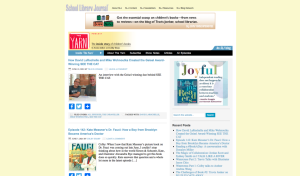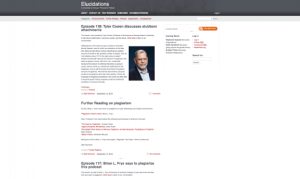 |
September 27, 2019 Volume 25, Number 39 |
General Interest |
Theme: International Podcast Day |
Tech Tools |
Revisited |
In the News |
General InterestBack to Top | |
 |
|
 |
|
 |
|
 |
|
 |
|
Theme: International Podcast DayBack to Top | |
 |
|
 |
|
 |
|
 |
|
 |
|
Tech ToolsBack to Top | |
 |
|
 |
|
RevisitedBack to Top | |
 |
|
In the NewsBack to Top | |
Iconic Television Artist Bob Ross Featured in Solo Exhibition in Virginia | |
|
The work of beloved TV artist Bob Ross is finally being recognized in an exhibition Little-known art gallery expects 15,000 people to check out its Bob Ross exhibit this month A Rare Exhibit Of Kitsch Landscapes by TV Artist Bob Ross Reveals the Unrecognized Genius Of 'The Joy Of Painting' The Real Bob Ross: Meet The Meticulous Artist Behind Those Happy Trees A Statistical Analysis of the Work of Bob Ross YouTube: Bob Ross For many people, one of their first introductions to art and painting came from the television show The Joy of Painting, which originally aired on PBS from 1983 to 1994. The main attraction of this show was its instructor Bob Ross, an American artist who became instantly recognizable for his halo of curly hair, casual button-down shirts, and his strikingly soothing way of speaking. Despite Ross's untimely death from lymphoma in 1995, his popularity remained steady and even increased as his shows became viewable online. Nonetheless, until recently very few people had been able to see any of Ross's famous landscape paintings in person. After the Smithsonian Institution acquired four of Ross's paintings earlier in 2019, this began to change, albeit in a somewhat unexpected way. Rather than being displayed in the Smithsonian (which currently has no plans to exhibit them), 24 of Ross's paintings are featured in an exhibition at the Franklin Park Performing and Visual Arts Center in the small town of Purcellville, Virginia, . This exhibition, entitled "Happy Accidents: An Exhibit of Original Bob Ross Paintings," marks the first time that Ross's work has received a solo exhibition on the east coast. The free event runs until October 15, 2019, but as of this write-up, all timed admission tickets have been claimed, and waiting lists are available for those who are interested. The speed with which the tickets disappeared is a testament to Ross's enduring popularity. [JDC] The first link leads to a September 2019 article written by Jacopo Prisco for CNN, announcing the exhibition and situating it in the context of the history of Ross's television show and his current status as an internet celebrity. The second link features a short article written by Rebecca Burnett and video news clip, both produced for the local news station WDVM in September 2019, stating that the Franklin Park Arts Center expects to receive 15,000 visitors for the Ross exhibit, or about half of their traffic for all of last year. At the third link, art critic Jonathon Keats shares his thoughts on Ross's merits as an artist and teacher in an article published by Forbes in September 2019 ahead of the exhibition's opening. For readers curious to learn the backstory of how Ross became a cultural phenomenon, the fourth link leads to an article written by Danny Hajek for NPR in August 2016, along with a seven-minute audio segment. Data-driven readers may appreciate the fifth link, which leads to a piece written by Walt Hickey for FiveThirtyEight, who conducted a statistical analysis of Ross's paintings that he created across the 381 episodes of The Joy of Painting that featured his work. Finally, readers who would like to try painting along with Ross (or who just want to be mesmerized by his soothing voice) can watch all 31 seasons of his show as well as the hour-long 2011 documentary Bob Ross: The Happy Painter on the official Bob Ross YouTube channel, available at the sixth link. | |





